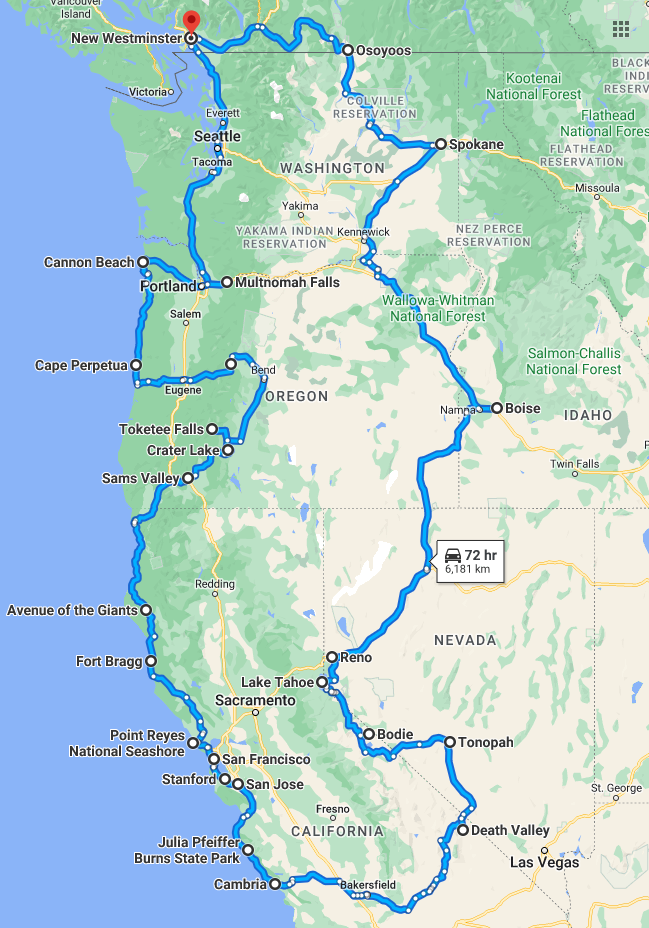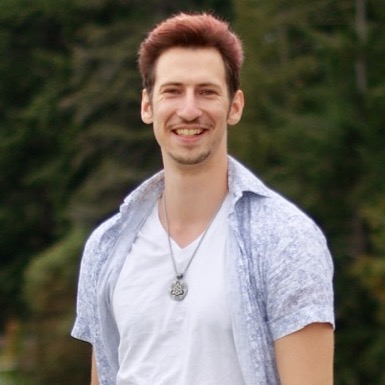Epic Roadtrip Time: Driving from Vancouver to Death Valley
Summer 2022: the travel bug itched like the woolliest of sweaters. Due to covid-related flight cancellations I had not left Canada in over three years (since the 2019 Rickshaw Run in India). With grad school finally completed and self-employment allowing me the flexibility to take time off, it was time to go on an adventure!
But where to? I didn’t quite feel up to flying just yet, so it was roadtrip time! I’d already driven east to Banff in 2019, north to the Yukon in 2020 with a tour of Vancouver Island on the way back, and explored the Sunshine Coast in 2021. For novelty that left going south to the USA. I thought about how far south I could comfortably go and settled on Death Valley as my destination.
Planning the Death Valley Roadtrip
I began combing through my travel list, seeing how many places I could reasonably explore in 12 – 14 days. I consulted Wikivoyage and asked friends for additional ideas. If I had more time I would have liked to add time hiking in Washington near Mount Rainier and Glifford Pinchot National Forest, exploring Oakland CA and geek tourism in Silicon Valley, seeing Yosemite Valley and Sequoia National Park (in hindsight, good thing I skipped those because they were largely on fire during the time I made this trip), and even extending the trip east into Arizona and Utah to see some of the geological monuments. But alas, all of that would have turned this into at least a 3 – 4 week journey which I couldn’t afford. Those ones will have to wait!
Death Valley Roadtrip Itinerary:
I eventually settled on the following plan:

- Day 1: Drive to the Waterfall Corridor in Oregon.
- Day 2: Early morning hike at Eagle Creek to see Punchbowl Falls. Drive to Astoria, Cannon Beach, and Cape Perpetua, then turn back east to camp at the McKenzie River.
- Day 3: Hike to the Tamolitch Blue Pool, then drive to Crater Lake and camp in a valley nearby.
- Day 4: Drive to Arcata, California and explore the Avenue of Giants en route to Fort Bragg.
- Day 5: Check out Fort Bragg’s glass beach and then drive to San Francisco. Exploring the nearby Point Reyes National Seashore along the way.
- Day 6: Full day exploring San Francisco.
- Day 7: Stop at Stanford University and San Jose, then continue further south on the California coast. Check out McWay Falls (Julia Pfeiffer Burns State Park) and camp at San Simeon Creek.
- Day 8: Breakfast in Cambria, and then a long drive to Death Valley’s relatively cool Washburn Campground. Stock up on plenty of supplies beforehand.
- Day 9: One day exploring Death Valley and then an evening drive to Tonopah, Nevada for stargazing.
- Day 10: A drive through the Eastern Sierra mountains to Lake Tahoe. Stops at Mono Lake and the ghost town of Bodie on the way. An evening drive to Reno, and then further north through Nevada to rest in Winnemucca for the night.
- Day 11: A long drive to Spokane with a brief stop in Idaho.
- Day 12: Explore Spokane and the nearby Coulee Dam. Then, a scenic drive through the Okonogan Forest and North Cascades before returning back home.
Why a Solo Roadtrip?
“What, no co-pilot?” friends and family would often ask me when I told them about this adventure. Well, there were practical limitations in coordinating vacation time with friends. And in finding friends crazy enough to join me on this one. But I had plenty of other reasons for doing this alone. I am a strong introvert, and when I’m at my best I prefer plenty of me-time. Solo travel fills this need while also feeding some of my core values such as exploration and self-reliance.
I was also completing this journey at a time of many transitions in my life. Over a month or so I found myself finishing grad school, launching a new career, indulging in new hobbies, and nurturing new and old relationships. In terms of personal growth I was working hard to reconcile my inner child with my sense of self. I was spending lots of time thinking about what seeds I want to plant going forwards into my next chapters. The notion of death and rebirth seemed fitting. While I love to share fun experiences with others, I thought that doing so would detract from some of my goals for this trip. This Death Valley roadtrip was just as much a retreat as it was a vacation.
Other perks of solo travel:
- I enjoyed being able to blast my metal music as loud as I wanted.
- Plenty of quiet thinking/reflection time whenever I desired.
- Full discretion for podcast/audiobook selection.
- Greater sense of flexibility with travel plans.
- Easier to stay within budget (in my experience).
- I have a fairly high tolerance for discomfort, so not needing to consider others was liberating in a way.
- Cheap, quick breakfast to save money and get more road time in? No problem.
- Want to get lost on a spontaneous hike? Okie dokie.
- Spend eight hours walking across San Francisco until my feet ached, to get a more intimate sense of the city than cars or public transit would allow? Yes please.
- Sleep in the car? Not recommended, but doable.
- Nobody to dissuade me from the insane and dangerous kinds of adventures that make for good stories.*
*In hindsight, this was detrimental at times, as I’m sure I’ll write about later.
I did take more selfies than I would’ve liked because there was often no one else around to snap a photo. And I missed having someone in the passenger seat to feed me snacks.
Ok, but WHY Death Valley in AUGUST??
It somehow did not occur to me until after I started putting my itinerary together that the hottest month of the year was perhaps not the best time to visit one of the hottest places on Earth. According to the NOAA, August high temperatures in Death Valley average 46.6°C (115.9°F). It reached at least 49°C (120.2°F) during my visit. Travel guides suggest the best time to visit Death Valley is in March and April during the spring wildflower bloom, or in the autumn when there are cooler temperatures and clear skies. Nonetheless, there were several reasons why an August visit appealed to me:
- Nice summer weather for the remainder of the roadtrip, through regions with more tolerable climates.
- The summer months are probably the least busy tourist season in Death Valley. It was still busier than I expected, but certainly not crowded.
- It’s a unique and beautiful experience for the adventurous!
- Camping at some of the cooler, higher-elevation campgrounds can actually be quite pleasant.
- An air-conditioned car is not a bad place to be during intense heat.
- I drive a hybrid-electric car, so this year’s soaring gas prices did not impact my decision very much.
There are of course safety considerations, and I will write in detail about that in another post.
Documenting the Journey
Each night on this trip I tried my best to write a recap of the day so long as time, battery power, and daylight permitted this. I always seem to struggle with this part, and even more so with finding the time and energy to turn those notes into something coherent and publishable. Hence why I am only getting around to these write-ups in November! But looking back now, I am glad I kept myself disciplined about my journalling. This was an incredible adventure and I am so excited to be able to share parts of it here.
















1 Comment
LEAVE A COMMENT